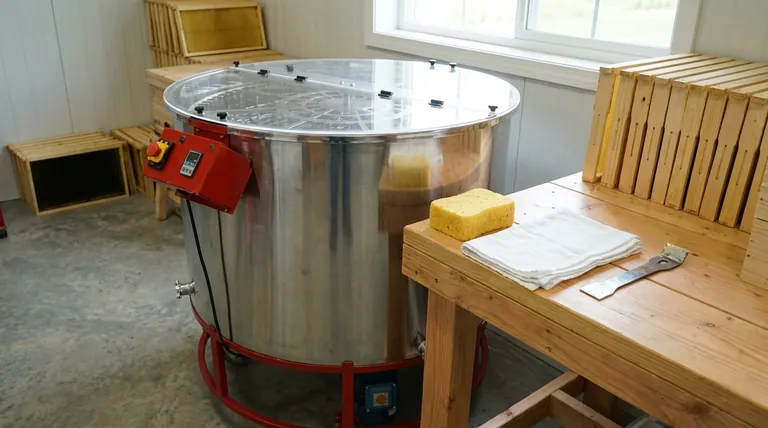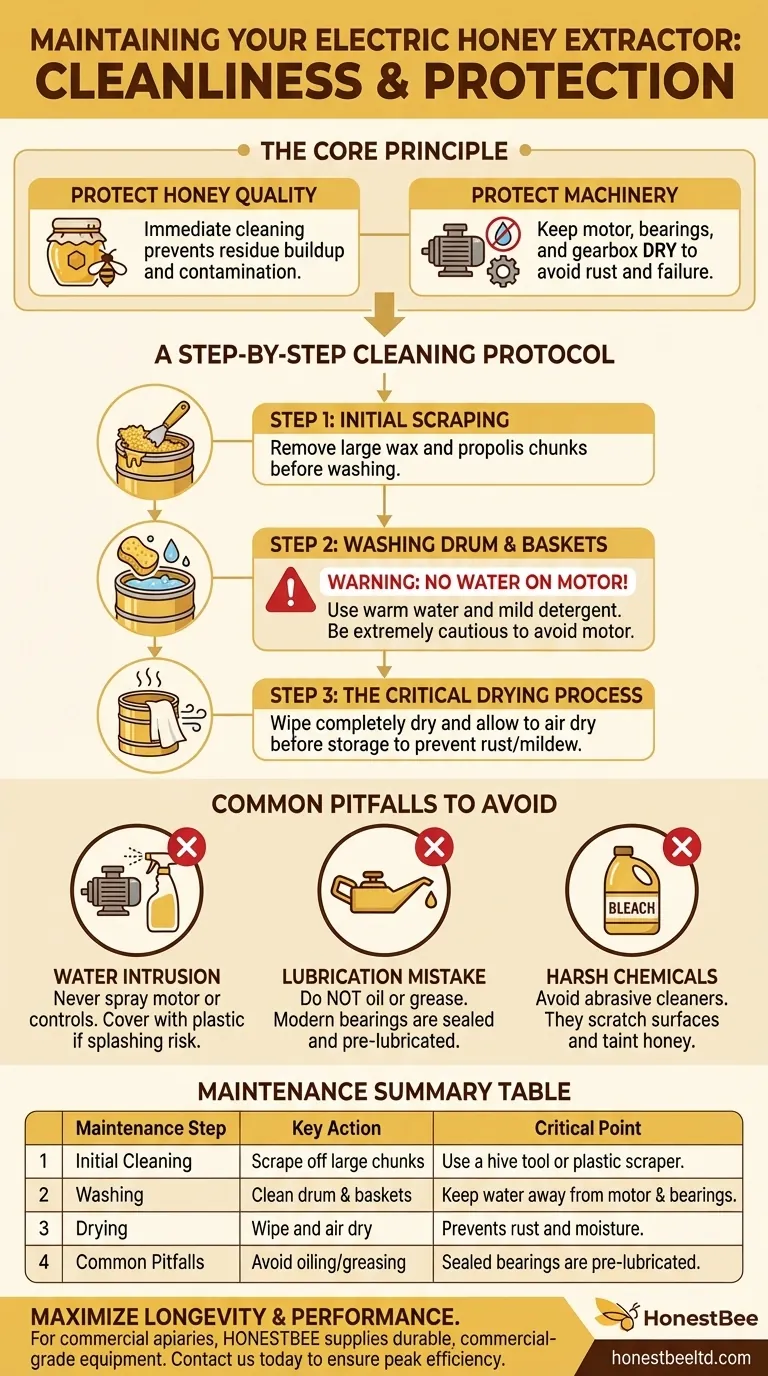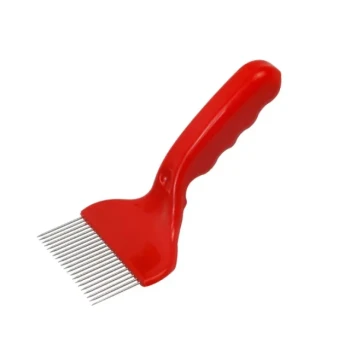Properly maintaining an electric honey extractor centers on a simple but critical rule: be meticulous with cleaning while being extremely cautious with its mechanical and electrical components. This involves thoroughly washing the drum and baskets with warm water immediately after use, but ensuring absolutely no water reaches the motor, bearings, or gearbox.
The core of electric extractor care is not complex mechanical servicing, but rather a disciplined cleaning routine. Your primary goal is to protect the sensitive motor and bearings from water and to prevent honey residue from hardening, which ensures both equipment longevity and the purity of your future harvests.

The Core Principle: Cleanliness and Protection
Understanding why you are performing certain maintenance steps is key to doing them correctly. The goal is twofold: protect the quality of your honey and protect the machinery from its biggest threats—water and neglect.
Why Immediate Cleaning is Non-Negotiable
Honey and wax that are left to dry inside an extractor become incredibly difficult to remove, almost like concrete.
Immediate cleaning with warm water melts and dissolves the residue easily. This also prevents the sticky mess from attracting ants, mice, and other pests during storage.
Protecting the Motor and Bearings
The primary difference between caring for a manual and an electric extractor is protecting the powered components.
Water intrusion into the motor, gearbox, or bearings is the fastest way to cause rust, electrical shorts, and catastrophic failure. These are the parts you must keep perfectly dry at all times.
A Step-by-Step Cleaning Protocol
Follow this simple process after every extraction session to keep your equipment in pristine condition.
Step 1: Initial Scraping
Before introducing water, use a hive tool or plastic scraper to remove any large chunks of wax and propolis from the interior drum and the baskets.
Step 2: Washing the Drum and Baskets
With the baskets still inside, use warm water and a soft cloth or sponge to wash the interior. A mild, food-safe detergent can be used to break down residues.
Some beekeepers use a pressure washer on a low setting, which can be effective but increases the risk of splashing water onto the motor. If you use this method, exercise extreme caution.
Step 3: The Critical Drying Process
Thoroughly rinse away all soap residue. Tip the extractor to drain all the water, then wipe the entire interior and all parts with a clean, dry cloth.
Allow the unit to air dry completely before reassembly or storage to prevent any chance of rust or mildew.
Common Pitfalls to Avoid
Correct maintenance is as much about what you don't do as what you do. Avoiding these common mistakes will save you significant trouble.
The Dangers of Water Intrusion
Never spray water directly onto the motor housing, control panel, or any area near the gearbox and bearings. Always cover these components with a plastic bag if there is any risk of splashing.
The Mistake of Lubrication
Do not oil or grease the extractor's moving parts. Most modern electric extractors use sealed bearings that are permanently lubricated.
Adding external lubricants can damage the seals, attract dirt and grime, and poses a significant risk of contaminating your honey.
Using Harsh Chemicals
Avoid abrasive cleaners or harsh chemicals. They can scratch stainless steel surfaces, creating areas for bacteria to grow, and can leave chemical residues that will taint your honey.
Making the Right Choice for Your Goal
Your maintenance routine should align with the scale of your beekeeping operation to ensure efficiency and reliability when you need it most.
- If your primary focus is hobby beekeeping: Diligent after-use cleaning and ensuring the unit is stored in a dry, pest-free location is the most important factor for long-term reliability.
- If you run a small-scale or sideline business: Standardize your cleaning protocol to make it fast and repeatable, and perform a quick mechanical and electrical check before the harvest season begins to prevent downtime.
Proper care protects your investment and ensures every batch of honey is as pure as the last.
Summary Table:
| Maintenance Step | Key Action | Critical Point to Remember |
|---|---|---|
| Initial Cleaning | Scrape off large wax/propolis chunks. | Use a hive tool or plastic scraper. |
| Washing | Clean drum and baskets with warm water. | Keep water away from the motor and bearings. |
| Drying | Wipe interior and air dry completely. | Prevents rust and ensures no moisture remains. |
| Common Pitfalls | Avoid oiling/greasing parts. | Modern extractors use sealed, pre-lubricated bearings. |
Maximize the longevity and performance of your extraction equipment. For commercial apiaries and distributors, reliable equipment is essential for a smooth, profitable harvest. HONESTBEE supplies durable, commercial-grade electric honey extractors and a full range of beekeeping supplies through our wholesale-focused operations. Contact our team today to discuss your equipment needs and ensure your operation runs at peak efficiency.
Visual Guide

Related Products
- HONESTBEE 72 Frame Industrial Electric Honey Extractor for Beekeeping
- 40 Frame Commercial Electric Honey Extractor for Beekeeping
- Commercial Electric 12 Frame Honey Extractor Spinner Motorized Honey Extractor
- 2 Frame Stainless Steel Manual Honey Spinner Extractor for Beekeeping
- 6 Frame Manual Stainless Steel Honey Extractor Beekeeping Equipment
People Also Ask
- What should a beekeeper do after extracting honey from supers? A Guide to Harvest Management
- What are the two common types of honey extractors? Choose the Right Extractor for Your Apiary
- What is the energy consumption like for automatic honey extractors? Maximize Your Harvest Efficiency
- Can a manual extractor be upgraded to an electric one? Save Labor & Boost Efficiency
- What are the advantages of automatic honey extractors? Scale Your Apiary with Unmatched Efficiency



















